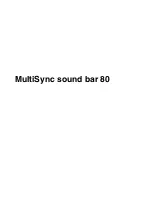
Connections to the loudspeaker system are made at the terminals
located on the back of the enclosure. These terminals permit a
variety of connection methods.
The most straightforward connection is made by directly connecting
clean bare wire. This connection is made by stripping
8-10 mm of insulation off the loudspeaker wire and passing the bare
wire through the hole in the binding post. If the wire is too thick to
pass through the hole in the terminal in one single bundle, separate
the copper wire into three equal bundles, then pass the center
bundle through the hole in the terminal. Wrap the remaining
bundles around the binding post and twist the center stands. The
knob can now be tightened securely, and any excess wire that is not
in contact with the binding post surfaces should be trimmed to avoid
short circuits.
A very convenient way of connection is the use of 4 mm banana
connectors, which are then, in turn, connected to the binding posts.
Bear in mind, however, that the number of contact points should be
kept to a minimum, and at the same time each contact should be as
tight as possible.
For the same reason, we recommend the use of the highest quality
spade connectors, expertly connected to the selected cables. Spade
lugs will make the best possible connection between the speaker
wire and the loudspeaker system, minimizing any contact resistance
that might degrade the sound ever so slightly.
Any connection in an audio system should not be considered "good
forever". All connections should be inspected and cleaned or
remade periodically. Frequency of maintenance depends on the
materials involved in the connection, atmospheric conditions and
other factors. Consult your dealer for specific recommendations.
It is essential that both loudspeakers in a stereo system have the
same polarity with respect to the input signal (are in "phase"). JBL
Ti-Series are designed to produce a positive pulse when a positive
signal is applied to the red input terminal.
If the driver cones of the two loudspeakers do not move in the same
direction for a given voltage at the input terminals, there will be a
lack of stereo definition and a loss of deep bass.
We recommend experimenting with the polarity of the speakers,
since recordings, program sources or power amplifiers can invert
the polarity of the signal. The "correct" connection is the one that
yields the best audible results. Be sure to reverse both left and right
connections to keep the systems in polarity.
BIWIRING
JBL TI-Series loudspeakers may also be connected to the amplifier
using two lengths of wire. The biwire connection method offers
several options and advantages.
The system's internal dividing networks are electrically separated at
the low frequency to midrange/tweeter transition. External strapping
bars connect the two parts of the network when a single wire
connection is used. The system is shipped from the factory with the
strapping bars in place. By removing the bars, connections may be
made to the individual network sections using two wires (four
conductors) as shown in Figure 1. The wires used may be of the
same type for both low frequency and high frequency sections. The
advantages are that wire effect (resistance, inductance, etc.) are
reduced and intermodulation of low and high frequencies in the
cable are avoided. Specialized wires for low frequency and high
frequency sections may yield excellent results in some systems. In
either case, low frequency cable should be as short as possible, and
the left and right cable for each section must be the same length. If
the cable to one speaker system is longer that the one to the other
speaker due to the distance from the amplifier, make sure not to
wind the excess cable up in the form of a coil. Instead, try to arrange
it in figures of eight, as this will minimize the inductance of the cable
run and thus minimize cable losses at high frequencies.
CAUTION: Never connect two amplifiers to the same loudspeaker
without first removing the strapping bars. Operating two amplifier
channels with the bars in place may seriously damage the amplifiers
and void the warranty.
Fig. 1: Ti input
Fig. 2: Ti input
Low Frequency
High Frequency
Amplifier
-
+
+
+
-
-
High Frequency
Low Frequency
-
+
+
-
High Frequency Amplifier
+
-
Low Frequency Amplifier
+
-




































